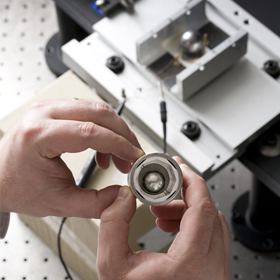Converting vibrations into an energy source

Defence scientists are investigating methods to harvest energy from vehicle vibrations to convert into electricity and power up diagnostic sensors and devices.
The concept of harvesting power from vibrations has gained interest amongst scientists over the past decade, in particular generating power for embedded electronics, ubiquitous computing, low-power sensing and wireless communications.
Vibration harvesters currently available in the commercial market tend to have a narrow bandwidth, are uniaxial in nature and tend to be quite bulky, limiting the practical take-up of this type of technology.
Scientists working for the DST Group have therefore focused on investigating a multi-axial, broad frequency bandwidth with high power density device that is compact, lightweight and simple to install.
Defence solution
DST has patented an energy harvesting approach that is based on the simultaneous rotation and translation of a rolling magnetic sphere.
As the sphere rolls, one of its magnetic poles passes a nearby wire-coil transducer which induces a voltage (otherwise known as an electro-motive force or e.m.f.) across the coil, which can then be used to charge up a battery.
Typically the harvesters developed by DST have a volume of 6 x3 x 3 cm3, small enough to fit into the palm of your hand.
Many applications
The Vibration Energy Harvester can be used to power applications such as Wireless Sensor Networks, Internet of Things, RF-identification and Condition Based Maintenance systems. It also promises to have an unlimited lifespan.
Unlike a battery, the vibration energy harvester does not 'run out'. As long as there is vibration, a vibration energy harvester will keep converting the waste mechanical vibrations into useful electricity.
Through the use of vibration energy harvesting, the maintenance and certification issues associated with traditional powering techniques are reduced as there are no batteries, copper wires or data-buses needed to power the diagnostic sensors and devices.

